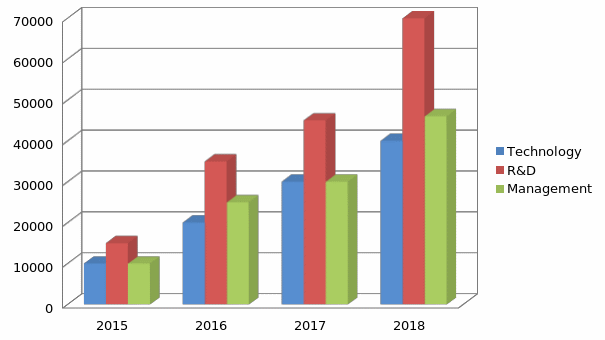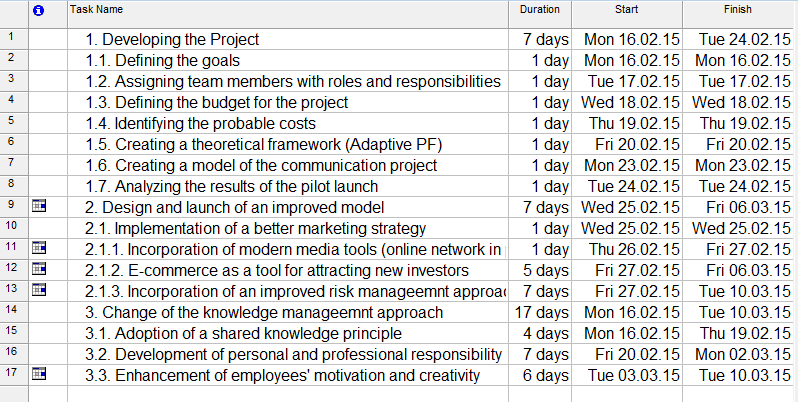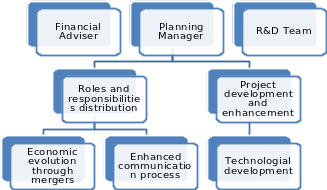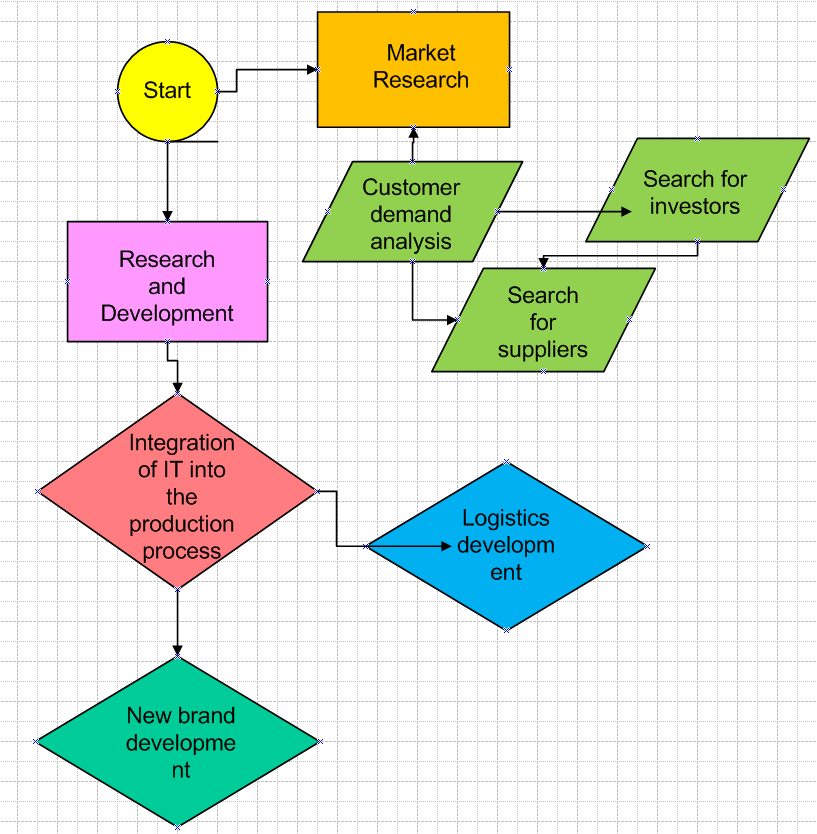Introduction and Summary
At the end of the 20th century, when the impending alterations to the existing concept of communication seemed inevitable, the Iridium Project was conjured. In order to advance the specified realm and promote more efficient communication, the project creators attempted at building a satellite network that would permit telephone transmission of all sorts of data possible (i.e., images, sounds, texts, etc.).
The Satellite Electronic Division R&D Group designed a system that allowed for the satellite communication concept to be implemented in 1987 (Kerzner, 2012). Although the project clearly succeeded in making telecommunication a commonly accepted and widely used phenomenon, Iridium still lacked a better management system.
As a result, the project suffered from the increasing competition with more successful organizations; in some way, the demise of Iridium was predetermined by the very premise of the concept – by making telecommunication available worldwide, the project could no longer be of as much use as it had been in providing access to mobile communication.
Strength and Weaknesses of the Iridium Project
When it comes to defining the key benefits of the Iridium Project, the location of the financial resources is traditionally the first feature mentioned. Indeed, the idea of all states that participated in the project design to share the revenues generated by Iridium calls was a rather smart move to make.
With all the credit to the developers of the project, one must admit that Iridium still has a few dents in it; specifically, the fact that the financial strategy had not been thought out thoroughly enough deserves to be mentioned (Gray & Larson, 2014). Indeed, while the idea of all partner countries contributing financially to facilitate the development of the project was moderately positive, the costs allocation seemed to leave much to be desired.
In addition, the schedule of the project could also have been designed I a better way. For instance, the extraordinarily fast pace that the company started with supposedly predicted a similarly expeditious evolution in the future. However, once the Iridium Project faced the need to alter its strategy due to technological innovations, the project obviously took a back seat to new telecom entrants and their innovations (Gray & Larson, 2014, p. 355).
Project Improvement
Cost Estimating
Because of a questionable cost allocation strategy, Iridium as a concept could not be deemed as credible from the very start; for the project to be viable, a more adequate cost allocation approach should be adopted. As Iridium demanded taking major expenses for its R&D department operation, it will be reasonable to suggest that the incorporation of a balanced scorecard approach, which permits the leaders of the project to allocate the costs in a more efficient manner.
Table 1. Cost Estimating (“Guesstimation”)

According to the table, the life-cycling factor does not seem to be an issue with the project in question. Moreover, the project is likely to receive enough financial resources as long as the promotion is successful and Iridium attracts the attention of investors.
Planning and Scheduling
As it has been stressed above, poor time management and organization of the schedule was one of the many issues that led to the untimely demise of the project. Therefore, an improved schedule for the Iridium Project should be introduced.
It can be suggested that the emphasis on the R&D aspect should be combined with a proper financial strategy based on a balanced scorecard approach (Wüstenhagen & Menichetti, 2012). With the help of the aforementioned strategy, one will be capable of reducing the costs for a range of internal processes, therefore, increasing the quality of the services provided to the end customer.
More to the point, it is imperative that the process of implementing the key goal, i.e., providing the customers with consistently good communication services, should be split into several key stages. In addition, with the attainment of the above-mentioned goal, the project will have to be updated so that no stalling could occur in the process of the Iridium evolution.
Picture 1. Iridium Progress Schedule: Timeline

Picture 2. Iridium Progress Schedule: Gannt Diagram

It seems that, with a good baseline, the former Iridium Project would have succeeded better in the global economy. Among the key problems of the project, the inconsistency with its objectives deserves to be mentioned. With a set of steps to be accomplished at specific points in tine, the project would have had more chances.
Contracting
As far as the contracting options are concerned, the Iridium Project should have evolved in accordance with a merger and acquisition policy. In other words, by encompassing every single major organization dealing with digital connection issues, the Iridium Project would have grown consistently over years.
Therefore, it can be suggested that the future project should acquire major companies dealing with mobile connection, including Motorola, Nokia, Siemens, etc. (Nagpal & Luutinen, 2013).
Communication and People Management
The incorporation of an efficient communication approach is the gateway to developing a successful system for the company to work in. As the case study in question shows, the lack of proper communication was one of the numerous factors that led to the inevitable failure. Therefore, for the project to become viable, an efficient communication tool is to be introduced.
In the specified case, the incorporation of technology, specifically, the use of corporate network as a means for data storage and information exchange, should be viewed as an option. It is desirable that the project manager should run the project; as a result, the delegation of responsibilities and the distribution of key roles can be carried out smoothly.
However, the introduction of a project manager into the project structure may disrupt the flow of information and isolate some of the members from the required data. As the chart provided below chows, the project under consideration will benefit from the structure that presupposes the distribution of equal amount of responsibilities to each member, therefore, facilitating a self-guided process.
Chart 1. Project Organization Chart

Progress monitoring and control
Naturally, the improvement of the project organization will require tightening the control over the key processes. Seeing that the project lacked the cohesion between the actions of the members since its very start, a baseline plan that will outline the key stages and distribute roles and responsibilities among the members is essential.
The baseline plan, in fact, can be viewed as the key resource that the members have at disposal (Gido & Clemens, 2014). Speaking of which, the Responsibility Chart below displays the perfect arrangement for duties and roles among the members of the project:
Table 2. Responsibility Chart: Roles and Functions Distribution
As the chart shows, it was crucial that the R&D department should receive the greatest amount of resources and help; however, the rest of the departments must have been sustained successfully as well. Herein the necessity to introduce the idea of shifts into the project lied.
In addition, since time is of essence, the incorporation of weekly reviews of the progress, monthly audits, weekly meetings with goals restatement and daily reports on the work completed were required. The project managers should also have kept the records of the key financial transactions, as well as deliver the notes on market analysis to the R&D Department in order to meet the customers’ demands.
Cost control
The cost control process could also have used major improvement. For instance, the previous cost control strategy that the Project Iridium leaders resorted to concerned the incorporation of networks required for tracking down the key costs taken by the company.
Because of the inordinately small amount of networks involved, the leaders of the project failed to reduce the amount of costs to the possible minimum; as a result, the untimely demise of the organization ensued, and the Project iridium was left without any financial support to sustain it.
In regard to the issues that the project managers were facing at the time, the significance of integrating several networks into the operation of the organization must be mentioned. Indeed, by creating the network that allows for a fast and productive communication between the project members, the one that helps store the key data and update the information concerning the project, and the one that contains the records of previous financial transactions, the cost control would have been much more executable.
Consequently, suggesting that the corresponding networks should be integrated into the operations of the project can be suggested. For instance, the budget and expenditures should have incorporated the calculations concerning both the direct and the indirect costs.
The analysis of the latter is the key to designing a proper costs allocation system and a sustainable financial policy. As the flow chart below chows, the project should have included both high and low income budget estimations. Moreover, as the chart displays quite clearly, there is an obvious need to encourage the process of market research so that the demands of the customers could become clearer and that the possibility forgetting investments from future partners should not be lost.
Chart 2. Flow Chart

Conclusion – A Long Way to Go
As much potential as the Iridium Project has, it still can use a lot of improvements, especially in terms of its financial policy, particularly, the costs allocation. In addition, the specified project seems rather dated in the 21st century, as the technology has advanced significantly since the creation of the Iridium Project; consequently, it will be good idea to incorporate modern technology in general and the phenomenon of social networking in particular.
In addition, a more flexible financial strategy In addition, the pace of the project implementation can be increased slightly without any major threat to the success of the steps taken. A perfect example of the way that innovations and communication can be integrated with the solutions to global concerns, the Iridium Project still retains its economic and technological potential, promising to return even greater results in the future.
Annotated Bibliography
Gido, J. & Clemens, J. P. (2014). Successful project management (5th ed.). Boston, MA: Cengage Learning.
A recent update on the 2005 discussion of what makes successful project management, the book by Gido and Clemens sheds some light on the subject matter. Being basically a manual on heading a project, it lists the key stages of the process and the resources required.
According to what the authors claim, efficient information flow and time arrangement are the key to project management. As the authors explain, the specified processes are only possible once a connection between the team members is established, which means that project management requires an efficient leader, who will be able to bring the team together.
Gido and Clemens make a very valid point concerning the significance of the key components of project management, such as information, time, financing, leadership, etc. As a result, their argument concerning the steps that need to be taken for carrying out a project successfully seem quite legitimate.
A minor weakness of the book, however, concerns the examples that the writers provide. Though quite graphic, they are far too few to be considered impressive. Overall, the book can be considered a decent resource. It is based on credible sources and was updated in 2014, which makes it quite contemporary.
Gray, C. & Larson, E. (2014). The rise and fall of Iridium. Project management: The managerial process (6th ed.) (pp. 351–368). New York, NY: McGraw-Hill Higher Education.
Using the story of Iridium as the example for supporting their theory, Gray and Larson make a range of valid statements concerning successful project management. The authors choose a rather peculiar approach by defining what is to be avoided instead of outlining the key steps to be taken. However, after the analysis of the Iridium project, the authors come to the conclusion that communication is the key towards making the project come to life.
The key strength of the study is that it is based off of an actual case, i.e., the Iridium Project. As a result, the article draws a series of conclusions that are applicable to a similar setting and can be used for addressing an actual problem developing in a business environment.
Published in a peer reviewed journal and backed up with a range of scholarly sources, the article in question can be considered quite credible. Moreover, this reading is crucial to understanding the problems of the Iridium Project.
Kerzner, H. (2012). How the seven deadly sins can lead to project failure. Revista de Gestão e Projetos, 3(3), 5–27.
Though Kerzner’s article can be considered as rather general, it still allows for locating the key problems with the failing entrepreneurships in general and the notorious Iridium Project in particular. Listing the key deadly sins and applying them to the business setting, the author points at the typical mistakes made by leaders of entrepreneurships, thus, preventing misunderstandings from occurring within the environment of an organization.
The article has a few very strong points, including its tendency to embrace every single process occurring within an organization. It is impossible to evaluate these processes when viewing them as separate, and Kerzner knows it. A major problem of the article, however, is that it tends to be preachier than it possibly needs.
While Kerzner clearly has a lot of valid points and delivers them in an orderly and detailed fashion, the article could still use a less condescending tone and a closer focus on the business aspect of the problem. Coming from a peer reviewed journal, the source can be deemed as credible. It can be used as the basis for defining proper ethics for the project.
Nagpal, P. & Luutinen, K. (2013). Key actors in the mobile telephone industry: feature phone years and the rise of Nokia. Review of Business Information Systems, 17(4), 171–178.
Nagpal and Luutinen render the topic that is becoming increasingly important in the modern business world; the authors carry out the analysis of major companies reaching global success. Choosing renowned organizations such as Nokia, the authors of the study carry out a detailed analysis of the components of these organizations’ success.
The incorporation of a detailed financial analysis, including the alterations in the cost of the company’s market shares, and the management issues into the analysis is an obvious advantage of the article. A strategy integrating various aspects of the company’s performance allows for locating the key dents in the corporate strategy.
However, as far as the research method is concerned, a mixed study with the inclusion of quantitative elements would have been more suitable, as there is an obvious need to compare the performance rates prior the intervention and afterwards.
Seeing that merging with other companies, such as Nokia, was suggested as one of the strategies for improving the functioning of the Iridium Project. Therefore, the article will be used as the basis for designing an adequate strategy for addressing the emerging issues.
Wüstenhagen, R. & Menichetti, E. (2012). Strategic choices for renewable energy investment: Conceptual framework and opportunities for further research. Energy Policy, 40(1), 1–10.
Introducing the audience to the balanced scorecard approach, Wüstenhagen and Menichetti identify the key financial issues that an entrepreneurship like the project iridium is most likely to face. Moreover, the authors also detail the way, in which these problems can be avoided. Costs allocation and budgeting are the key to establishing an efficient company, as Wüstenhagen and Menichetti explain.
Bringing up the concept of renewable energy as the potential resource for keeping the entrepreneurship, the researchers make a breakthrough in the company management theory. Therefore, the given concept can be considered the key strength of the article. The lack of focus on other aspects of a company’s functioning, though, is obviously a problem.
The article was published in a peer-reviewed journal, which makes it a credible source. Thus, it will be used as the key to developing the financial strategy of Iridium. Wüstenhagen and Menichetti’s work is a good addition to the list of resources for this study.
Reference List
Gido, J. & Clemens, J. P. (2014). Successful project management (5th ed.). Boston, MA: Cengage Learning.
Gray, C. & Larson, E. (2014). The rise and fall of Iridium. Project management: The managerial process (6th ed.) (pp. 351–368). New York, NY: McGraw-Hill Higher Education.
Kerzner, H. (2012). How the seven deadly sins can lead to project failure. Revista de Gestão e Projetos, 3(3), 5–27.
Nagpal, P. & Luutinen, K. (2013). Key actors in the mobile telephone industry: feature phone years and the rise of Nokia. Review of Business Information Systems, 17(4), 171–178.
Wüstenhagen, R. & Menichetti, E. (2012). Strategic choices for renewable energy investment: Conceptual framework and opportunities for further research. Energy Policy, 40(1), 1–10.